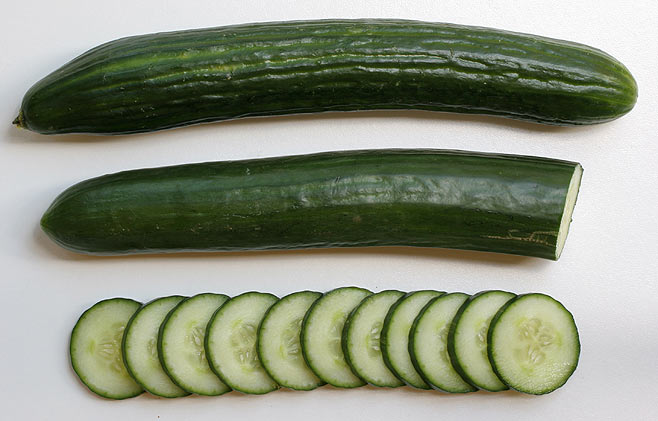|
Cucumis sativus (Cucumber) Life
> eukaryotes >
Archaeoplastida >
Chloroplastida
>
Charophyta > Streptophytina > Plantae (land plants)
> Tracheophyta (vascular plants) > Euphyllophyta > Lignophyta (woody plants)
> Spermatophyta (seed plants) > Angiospermae (flowering plants)
> Eudicotyledons > Core Eudicots > Rosids > Eurosid I
> Order: Cucurbitales > Family: Cucurbitaceae
 |
|
English cucumber. [photo H. Robertson, Iziko
©] |
Originates from a wild species growing in India that was domesticated more
than 2000 years ago. Cucumbers today are mainly grown in hothouses. They are
usually eaten sliced in salads or on sandwiches but are also blended up for cold
sauces and soups. Less commonly, they are used in cooked dishes. Young cucumbers
are pickled as gherkins (see true Gherkin).
Cucumis sativus is a cultigen species,
thought to be the result of selective breeding of Cucumis hardwickii
which grows from the foothills of the Himalayas through to Arabia. There are
bitter terpene compounds called cucurbitacins in fruit of the wild species so
presumably domestication partly involved selecting for fruit that were not
bitter. It is unclear when cucumbers started being cultivated but their original
domestication is thought to have taken place in India prior to 2000 BC. The
classical Greeks and Romans ate cucumbers, the Romans evidently cultivating them
in the first century AD in some sort of greenhouse (presumably no glass).
Cucumbers today are mainly grown in hothouses. They are
usually eaten sliced in salads or on sandwiches but are also blended up for cold
sauces and soups. Less commonly, they are used in cooked dishes. Young cucumbers
are pickled as gherkins (see true Gherkin).
References
-
Sauer, J.D. 1993. Historical geography of
crop plants - a select roster. CRC Press, Boca Raton, Florida.
Text by Hamish Robertson |
